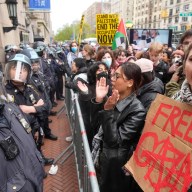getty images photo
The red-suited incarnation of Santa Claus is a product of Coca-Cola’s marketing department from between the two world wars, our columnist writes.
GHOSTS OF CHRISTMAS PAST: The holiday season is here, bringing with it the usual cornucopia of seasonal programming of variable quality. Everyone has at least some sort of Christmas-themed program waiting in the queue, and the roll-out has already started. CBC has Christmas Confidential airing on the 14th, an apparently tongue-in-cheek exposé of the Christmas industry, and the History Channel is airing In Search Of Santa Claus the next day, a history of Saint Nicholas “combining re-enactments of miracles, unique graphic effects and different styles of filming,” according to the press release.
One major factoid I picked up from Hey, Remember Christmas?, an HGTV holiday special airing this Sunday at 9 p.m., is that the red-suited incarnation of Santa we know today is basically a product of Coca-Cola’s marketing department from between the two world wars, some art department’s bright idea that ended up striking a resonant chord in the public imagination.
Hey, Remember Christmas? is an odd viewing experience. It features potted histories of various aspects of the North American holiday experience, like the Christmas tree, real and artificial, tinsel, strings of coloured light bulbs, the evolution of tree ornaments, and various waves of holiday toy hysteria — as a onetime department store toy department clerk, I’m a veteran of the Cabbage Patch Kid, Teddy Ruxpin and Transformer riots of the mid-‘80s, so these sections had particular resonance for me.
The dominant tone of the American-produced show is nostalgia, but it’s a strange, free-floating sort of nostalgia, that recalls things like department store Santas, preadolescent Christmas Eve insomnia, covert present hunts in parental closets and attics, and Christmas pageants as bygone artifacts of the past, as if some cultural rupture had created a gulf between a more innocent, vivid past and some austere present.
You could blame this on the Baby Boomer-centric perspective of the show — the past was always better/worse/more intense/less materialistic if you were born in the great postwar demographic bulge — so it’s no surprise when old 8mm footage of Christmas mornings are used as a window on this vanished world, but it gets a bit strained when various thirtysomethings, a young woman in her mid-twenties, then a teenage boy, bear witness to Yule’s paradise lost.
An alien viewer, encountering the show as their first glimpse of our culture, would assume that Christmas and all of its peculiar thrills had been outlawed some time in the past decade, perhaps even discarded in the wake of 9/11. If the show had allowed itself to get a bit philosophical, it might have reflected to itself that, once you’ve passed the age of majority, our secular experience of Christmas becomes an eternal past, owned by children but maintained by harried and vaguely envious generations of adults.
















